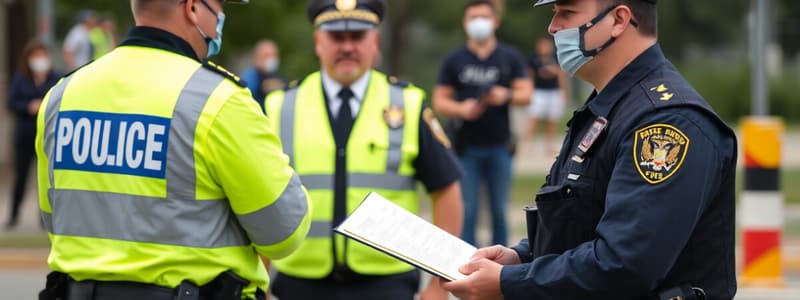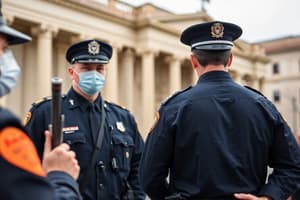Podcast
Questions and Answers
Which action is LEAST likely to foster police legitimacy within a community?
Which action is LEAST likely to foster police legitimacy within a community?
- Ensuring officers treat all individuals with respect during encounters.
- Strictly enforcing laws regardless of community input or context. (correct)
- Actively seeking community feedback on police policies and practices.
- Implementing community policing initiatives focused on problem-solving.
A person experiencing a crisis reports feeling detached from reality and unable to concentrate. Which of the following would be the MOST appropriate initial response?
A person experiencing a crisis reports feeling detached from reality and unable to concentrate. Which of the following would be the MOST appropriate initial response?
- Advising the person to take medication or seek professional help later.
- Immediately attempting to solve the underlying issues causing the crisis.
- Reassuring the person that everything will be alright and minimizing their concerns.
- Actively listening, acknowledging their feelings, and ensuring their immediate safety. (correct)
Which of the following scenarios BEST exemplifies a 'critical incident' leading to a crisis?
Which of the following scenarios BEST exemplifies a 'critical incident' leading to a crisis?
- An individual experiences chronic stress due to ongoing financial difficulties.
- An individual makes a mistake at work, leading to a reprimand.
- An individual feels worried about an upcoming job interview.
- An officer is involved in a shooting, leading to intense media scrutiny and internal investigation. (correct)
How does understanding the elements of crisis formation BEST assist law enforcement officers in de-escalating situations?
How does understanding the elements of crisis formation BEST assist law enforcement officers in de-escalating situations?
A person is experiencing a developmental crisis related to a significant life transition. Which scenario BEST illustrates this type of crisis?
A person is experiencing a developmental crisis related to a significant life transition. Which scenario BEST illustrates this type of crisis?
A person is exhibiting behavior that officers recognize as a potential crisis. Which officer action is MOST likely to lead to a successful de-escalation?
A person is exhibiting behavior that officers recognize as a potential crisis. Which officer action is MOST likely to lead to a successful de-escalation?
During a crisis intervention, an officer uses verbal de-escalation techniques but notices the situation is worsening. Which is the MOST appropriate next step?
During a crisis intervention, an officer uses verbal de-escalation techniques but notices the situation is worsening. Which is the MOST appropriate next step?
An officer recognizes that a person in crisis seems to be disengaging from the interaction. What tactic would BEST help re-establish a connection?
An officer recognizes that a person in crisis seems to be disengaging from the interaction. What tactic would BEST help re-establish a connection?
When offering resources to a person in crisis, what approach is MOST effective according to crisis intervention principles?
When offering resources to a person in crisis, what approach is MOST effective according to crisis intervention principles?
Which statement accurately reflects the relationship between anger and listening ability in a person experiencing a crisis?
Which statement accurately reflects the relationship between anger and listening ability in a person experiencing a crisis?
Flashcards
Police Legitimacy
Police Legitimacy
The public belief that the police have the right to exercise authority.
De-escalation
De-escalation
Actions that reduce the intensity of a crisis and restore equilibrium.
De-escalation Tactics
De-escalation Tactics
Tactics used to reduce tension or conflict intensity.
Motivational Interviewing
Motivational Interviewing
Signup and view all the flashcards
Warm Handoff
Warm Handoff
Signup and view all the flashcards
Containment
Containment
Signup and view all the flashcards
Crisis
Crisis
Signup and view all the flashcards
Anticipation Stress
Anticipation Stress
Signup and view all the flashcards
Empathy
Empathy
Signup and view all the flashcards
Mental Illness
Mental Illness
Signup and view all the flashcards
Study Notes
- Empathy is not one of the four pillars of procedural justice.
- The four pillars of procedural justice are neutrality, voice, and respect.
- Fairness is most associated with procedural justice.
- A symptom of being in crisis involves being unable to sleep or having repetitive dreams.
- A critical incident is described as any event or set of events that causes a person to become stressed to the point of dysfunction.
- Police legitimacy is the public belief that the police are entitled to exercise authority.
- Less cooperation and support is not one of the benefits of having police legitimacy.
- Lower stress levels and improved safety, less crime, and fewer complainants are benefits of having police legitimacy.
- Failure of a person's coping mechanisms and perception of an event causing subjective distress and disequilibrium are elements of crisis formation.
- A developmental crisis can be the result of normal, expected, transitional phases as people move from one stage of life to another, such as marriage or the birth of a child.
- Trauma is how each person processes and reacts to the bad stuff that happens as part of one's history.
- Not all forms of crises are considered harmful (False).
- Anticipation stress is described as worried about what might happen in the future.
- Trauma does not usually affect everyone the same.
- Experiencing ongoing abnormal and dysfunctional thinking, feelings, or behavior is described as a mental health crisis.
- Police will not generally use different de-escalation and crisis intervention tactics when working with someone under the influence of drugs or alcohol.
- Recognizing the signs and symptoms of a crisis can help police determine which intervention and de-escalation strategies and tools to use.
- In conducting a Basic Risk Assessment, someone who is considered High mental illness/High risk is considered the most dangerous and highest priority.
- Actions taken to reduce the intensity, bring the crisis to an end, and return to a state of equilibrium is known as the de-escalate step in crisis intervention.
- Putting a jar over the incident and actions taken to prevent the crisis from worsening or spreading describes the contain step in crisis intervention.
- Disengagement with a plan is a tactic of removing police resources when the risk of action exceeds legal obligations and the threat to others, with a deliberate plan to reengage later.
- Active listening builds rapport.
- Paraphrasing includes actions, communication topics, and strategies.
- "Your pain is understandable, considering how difficult your situation is,” describes a reflection of feelings.
- It is not true that only one police member should talk to a person in crisis at any given time.
- Engaging in active listening involves validation.
- Telling a person in crisis to “Calm down” is not considered effective in crisis communications.
- A common mistake police officers make is moving to problem-solving too soon when engaging in the crisis communication process.
- The AAA of Crisis Communications does not include Analyze.
- Containment is described as setting a perimeter to control variables and prevent the spread of the event and entry/exit into the scene.
- Reducing distance to the person in crisis is not a de-escalation tactic.
- De-escalation is described as tactics used to reduce tension or the intensity of a conflict, confrontation, or crisis situation.
- The use of tactical breathing can improve emotional self-regulation and prevent emotional hijacking.
- The more signs, symptoms, and clues that a person presents, the higher the risk of suicide.
- When asking a person if they are contemplating suicide, ask directly.
- Hopelessness, helplessness, and not seeing a solution to one's problem(s) are the hallmarks of a suicidal individual.
- Dont move to problem-solving early in the communications process with a suicidal individual.
- When attempting to convince someone not to attempt suicide, do not use your values, religion, and culture as effective communication strategies.
- Discussing suicide will not cause a person to attempt suicide.
- In crisis intervention, more attention placed on the reasons for dying does not elevate the reasons for living.
- Motivational interviewing is defined as a collaborative, goal-oriented style of communication with particular attention to the language of change.
- Motivational interviewing can be applied to different groups involving culture, gender, and ethnicity and issues including addiction, illegal behavior, and crises.
- The Crisis Communication Process and the Crisis Communication Template are also effective with crisis communication on the phone and through text messaging.
- The core skills used in motivational interviewing are the same as those in the Crisis Communications Process.
- A warm handoff connects a person to another police member or resource by introducing the joining member, summarizing relevant details, and giving the person an opportunity to clarify misconstrued information.
- Interrogations tend to be domineering and manipulative, often using emotional leverage and attempting to pierce through resistance.
- Older generations tend to prefer texting over the phone or face-to-face communication.
- Verbal containment is accurately described when, as long as the person is talking with the police, that individual is less likely to simultaneously engage in negative actions and harmful behaviors.
- A person in crisis that has 0 – 5% communication ability is like communicating with someone engaging in a 2-year-old tantrum.
- The angrier a person is, the less their ability to listen.
- Persons who are suicidal are usually homicidal.
- Fear of consequences is not a risk factor for violence.
- History of violence is not an inhibitor of violence.
- When offering resources to a person in crisis, begin with the basic, unmet needs first.
- Transport out of the community and drop off is not one of the disposition options for police at crisis scenes.
Studying That Suits You
Use AI to generate personalized quizzes and flashcards to suit your learning preferences.




